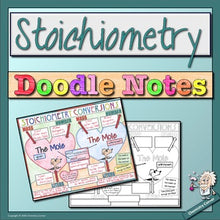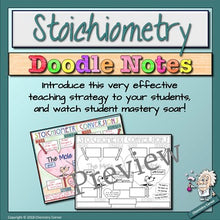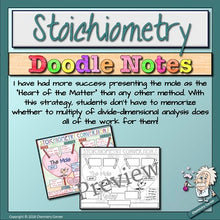The mole heart! I have found that one of the hardest things for students when doing stoichiometry problems is determining what numbers to put where. By using this graphic, my intention is to make the process as simple as possible. The heart is something that students can visualize easily. Also, there is no reason to have students memorize where to multiply and where to divide. I think this is one of the biggest things that make these problems more difficult than necessary. We just concentrate on the dimensional analysis!
Students will gain so much value from these doodle notes that they will be proud of and use! The included teacher notes suggest many ways of incorporating doodle notes in your class, and includes an example suggestion for completing the doodle notes. For interactive notebooks—just print at 90%, and it will fit beautifully!
Chemistry Doodle Notes! Research is now coming available that sites that doodling while learning forms a connection between left brain and right brain communication and enhances learning. “Cross-brain” learning has many benefits for the student—most importantly, the activity of doodling will give your students a kinesthetic connection to core concepts.
These Doodle Notes lay out the process of working stoichiometry problems in a completely visual and simple manner. This very successful teaching strategy is one that I have been using for years with great success. My students become stoichiometry masters after this lesson, and have told me tales of teaching their friends, college classmates, and youth groups stoichiometry.
The doodle notes address stoichiometry conversions involving mass, number of particles, and molar volume (liters) @ STP.
Objectives:
Define the process of working stoichiometry problems.
Identify where to find numbers, or what numbers to use for conversion factors.
Prior Knowledge for Students: Students should be comfortable with dimensional analysis, and mole conversions prior to this lesson.
Teacher Prep Time: Just print and go!
Lesson Duration: One – One class period plus practice.
Included in This Product:
The Stoichiometry Conversions Doodle Notes
Suggested KEY for the notes
Teacher Notes with suggestions for incorporating doodle notes in your class, and other tips. (3 pages)
This lesson is appropriate for grades 9-12 chemistry.
This will be an activity you will want to use year after year!
Chemistry Corner
**************************************************************************************
Check out these other products that you may be interested in:
Stoichiometry: The Complete Lesson
High School Chemistry Year Curriculum
Chemistry Doodle Notes for the Year
*************************************************************************************
LICENSING TERMS: By purchasing this product, you own a license for one teacher only for personal use in your classroom. Licenses are non-transferable, meaning they cannot be passed from one teacher to another. No part of this resource is to be shared with colleagues or used by an entire grade level, school, or district without purchasing the proper number of licenses. I you are a coach, principal or district interested in transferable licenses to accommodate yearly staff changes, please contact beth@chemistrycorner.com.
COPYRIGHT TERMS: ©Chemistry Corner. Please note – all material included in this resource belongs to Chemistry Corner. By purchasing, you have a license to use the material, but you do not own the material. This resource, or any portion of this resource, may not be uploaded to the internet in any form, including classroom/personal websites or network drives, unless the site is password protected and can only be accessed by students—no other teachers or anyone else on the internet.






